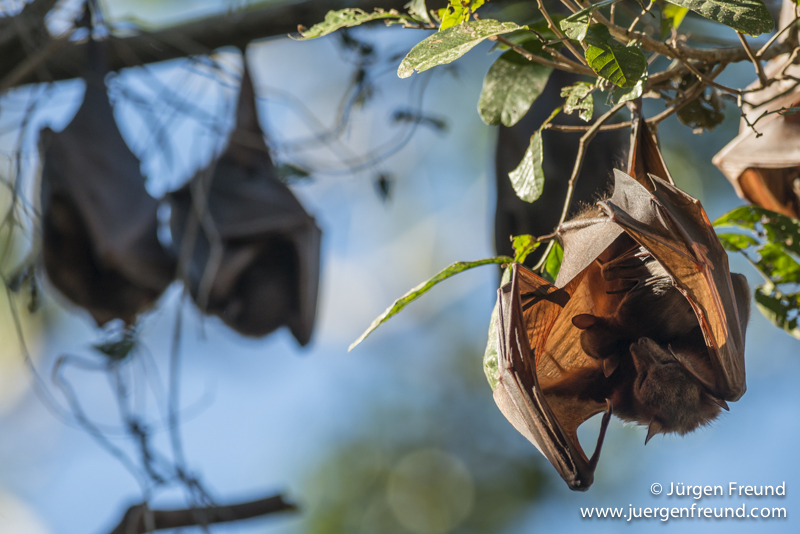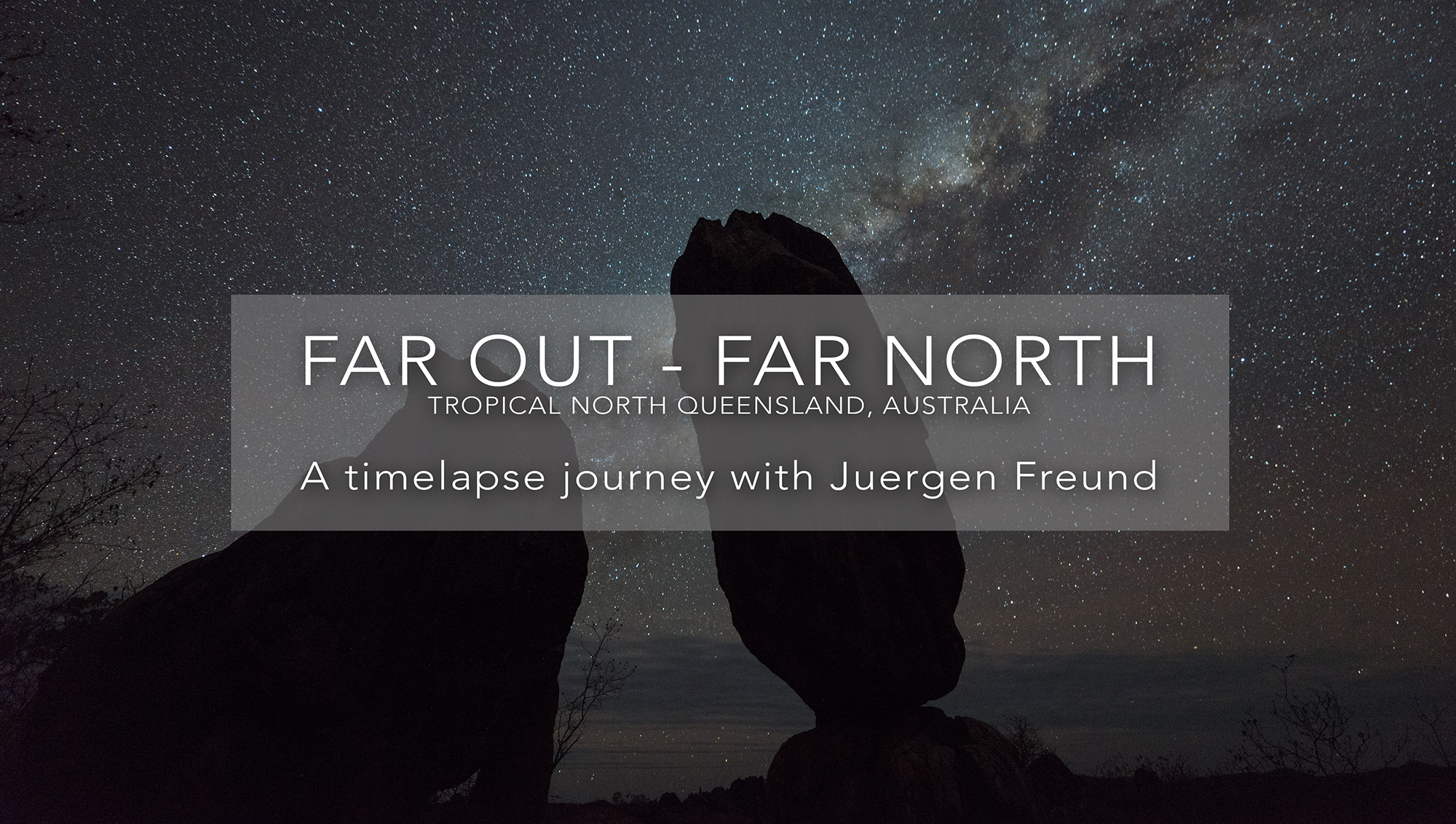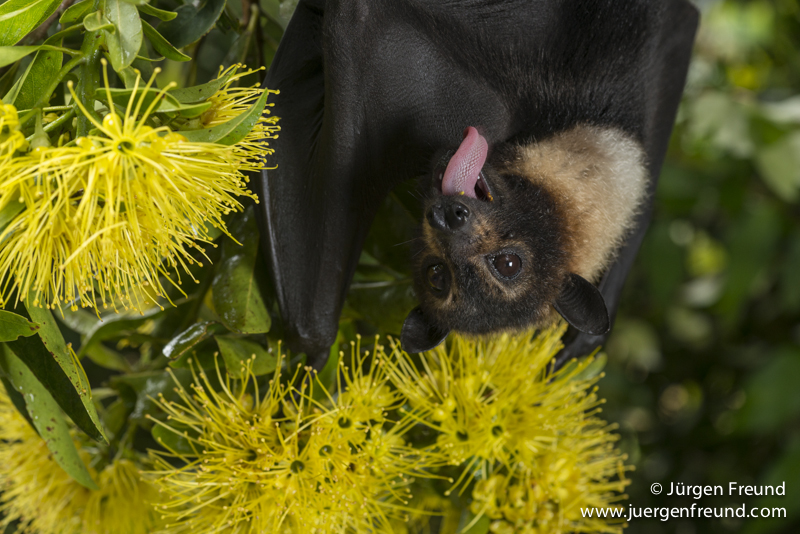April 2009 – September 2010
In 1995, when I was a fresh full-time wildlife photographer – after quitting my Industrial Photography day job of many years, I went for 12 months on my very own photographic expedition through the Coral Triangle. I first visited Christmas Island, Australia for half a year to document the red land crab migration and whale sharks found in the clear waters of the Indian Ocean. After 6 months on that magic island, I travelled through the Philippines, Sabah Malaysia and Indonesia, traveling to the many places that we re-visited on this current expedition.
CAMERA EQUIPMENT AND ACCESSORIES
Back then I brought my Nikon film cameras and 1000 rolls of 35mm Fuji film along with some developing chemicals and an E6 developing machine to get instant results of my work. My Mac Notebook computer back then only had a black & white screen and a 150MB Harddrive (the size of only two TIFF size pictures nowadays). Email was the newest thing then, unknown to even many top international magazine photo editors. Old dive guides & Edi Frommenwiler from the dive liveaboard Pindito still remembers me developing my pictures in the back deck of this beautiful phinisi while I traveled with him around Raja Ampat in 1996-97! Even Raja Ampat was widely unknown back then.

We travelled with about 150kg of equipment, mostly dive and photo gear, by air, ship, bus, car and motor bike.
Today modern technology makes photography and travelling so much easier. Our MacBooks have 1TB Harddrives and there are no more films, let alone chemicals to lag around. The number of images are only limited by my work effort and size of my hard drives.
To accomplish the mammoth task of shooting wildlife, underwater and topside for straight 18 months, with most likely no chance for any maintenance if there was a breakdown, we decided from the onset to bring the most reliable equipment. I have been shooting with Nikon cameras for the past 20 years, so there was no changing of anything. I needed familiarity with all my camera equipment and I already had all Nikon lenses. I had 2, by this time old and dated Nikon D200 camera bodies and a Nikon D3. As this was a massive assignment, we decided to buy the two latest Nikon camera bodies for this job – a Nikon D700 & a Nikon D3x. But I had to sell my D3 to do this 🙁
So, what’s in the box?
- Nikon D3x (26MP for high resolution images)
- Nikon D700 (13MP for low light and all around images)
- Nikon D200 (Backup)
- Nikon 10.5 mm Fisheye (mainly for underwater)
- Nikon 16 mm Fisheye (mainly for underwater)
- Nikon 24 mm Tilt/Shift lens (to extend depth of field on planes)
- Nikon 14-24 mm lens (general wide zoom, topside)
- Nikon 18-35 mm lens (general wide zoom, underwater)
- Nikon 24-70 mm lens (general mid zoom, topside)
- Nikon 70-300 mm lens (topside)
- Nikon 80-400 mm lens (topside)
- Nikon 105 mm micro (for close ups)
- Set of extension rings (for more close ups)
- Three SB800 land strobes and a wireless SU800 control unit
- Two SEACAM underwater housings for the D3x and D700 with four uw strobes
- Manfrotto carbon tripod, an old one that I could also use underwater
- Arca Swiss ballhead with Really Right Stuff Panoramic clamp
- Foldable solar panel to charge batteries
UNDERWATER PHOTO GEAR
One of the most important things to shoot on this journey is the underwater world of the Coral Triangle. To do so I needed the right tools.

Our trusty two SEACAM underwater housings with their strobes or flashes
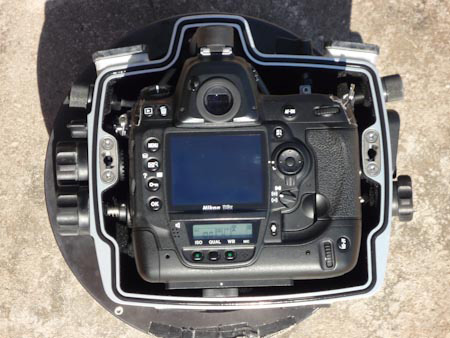
And this is how the uw camera looks from the inside
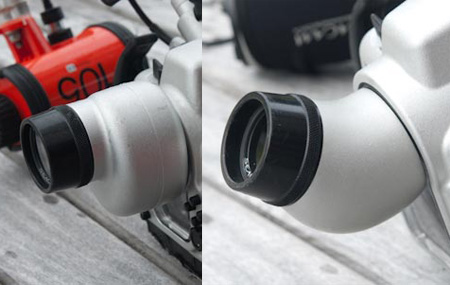
Depending on the situation I choose either a straight or angle finder to focus on my subject.
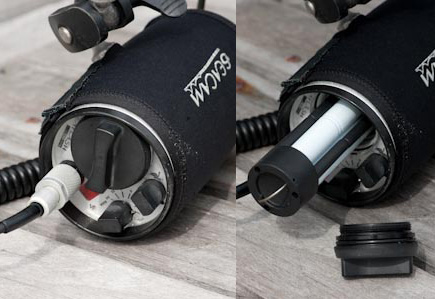
In order to get all the colours right underwater I use two of these SEACAM uw strobes or flash-lights. The batteries are exchangeable to have a second pair charging while I am shooting with the first.

Underwater cameras need a lot of tender loving care in order to function properly and not flood the camera to a sudden death
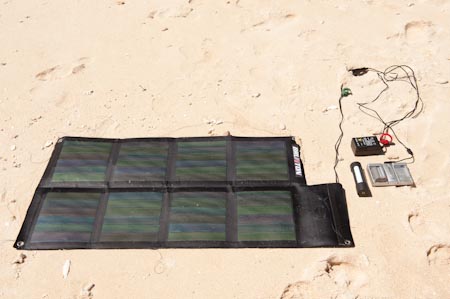
And in case there was no electricity, we brought a foldable Brunton solar panel which could charge my strobes, camera batteries, torches and our little subnotebook computer
Our first liveaboard trip in Indonesia was in Komodo. We were with many underwater photographers there and we all kept our cameras on the long deck table of the luxurious Seven Seas.
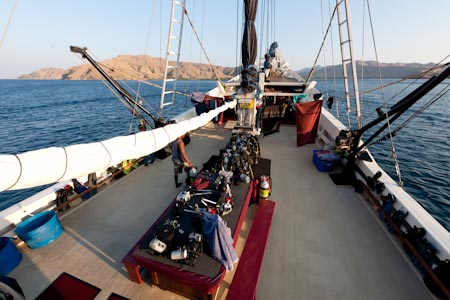
This is how the underwater photo equipment is easily accessible on a dive liveaboard. Grab the camera and jump in the dinghy to photograph one of the best reefs in the world.
UNDERWATER PHOTOGRAPHY
I really like images that show both, the underwater world and topside in one image. We call these pictures “split levels” but they are also known as “half-and-halfs” or “over-unders”. In most cases I use a fisheye lens for them with an angle of 180º from corner to corner. Fisheye lenses are about the widest lenses you can get and this does the job very well. Here is how I do it:
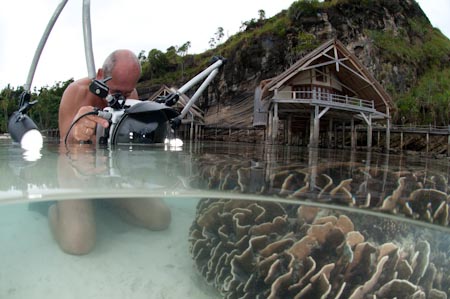
I take the largest glass dome port I have (called Superdome) and keep it half out of the water. I avoid water drops on the upper part by simply spitting on the outside glass. The focus I generally set under water but that depends on the subject. In order to maximise the depth of field, I choose about f-stop 16 and adjust the exposure time accordingly.
Above is me in Misool Eco Resort, Raja Ampat, Indonesia and behind me was our wonderful bungalow . . .
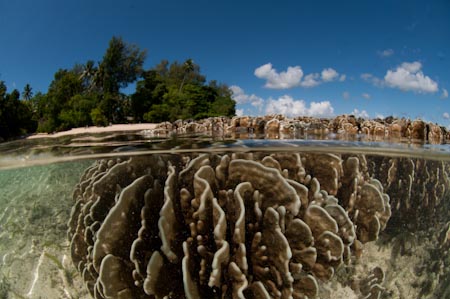
. . . and this is how the split level looks like . . . but in Lissenung Island. Same type of coral, different location. Fooled you, didn’t I . . .
Lissenung Island is in New Ireland, Kavieng Papua New Guinea.
One of the biggest problems underwater is the loss of colours with growing depth and water clarity. Depending on weather, location or even fellow divers stirring up the silt, visibility can be as low as zero. But under normal circumstances in the tropical oceans, it would be about 10 to 30 meter average viz. The bigger challenge is the loss of colours at growing depths (and distances). The colour red disappears from 5 meter depth onwards. To compensate for all these factors, it is best to be as close to the photo subject as possible and use one or two uw strobes. For most of my underwater wide-angle shots, I like to use a fisheye lens. As much as these kind of lenses distort on land, it is the perfect lens for underwater use, because I can go really near the subject. Here are some examples:
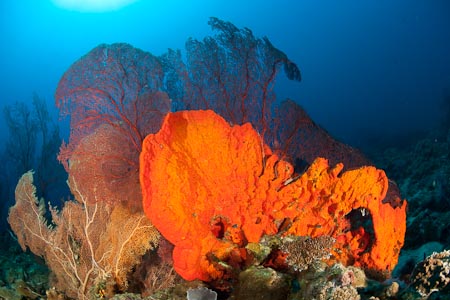
A 6 meter wide fan coral in Kimbe Bay.
We stayed in Walindi Plantation Resort in Kimbe Bay in West New Britain, Papua New Guinea.

Manta ray off Kri Island, Raja Ampat, Indonesia
We dived with Max Ammer of Sorido Bay Resort, Kri Island. It was only 7 miles by boat to the manta ray place.
I used to be an engineer a very, very long time ago, and had never liked that job at all, but it taught me some very useful skills. One of it is that I can design and manufacture gadgets for my photographic needs – underwater and topside alike. I like to shoot animals in their natural environment, no matter how big or small they are. For the small creatures, instead of a large dome glass that I used for big manta rays, I needed a very small one which I made a long time ago from acrylic. But acrylic is very prone to scratching. After a design brainstorming session with Harald Hordosch of SEACAM, he redesigned my acrylic dome in glass that is now traded by SEACAM as “Fisheye Macro Port“. But Stella calls it “The Yogi Dome”.

Our WWF ranger team could get this baby green turtle (and some of its siblings) away from the villagers in one of the Wakatobi islands where we released them back to the wild. This picture is taken with the tiny glass dome that Stella calls “The Yogi Dome”.
The underwater world is full of wonders, and as closer you look the more wondrous it gets – there is detail in the details. In order to shoot these tiny subjects, I need a different uw camera setup. Generally I use a 105 mm Micro lens to get close.
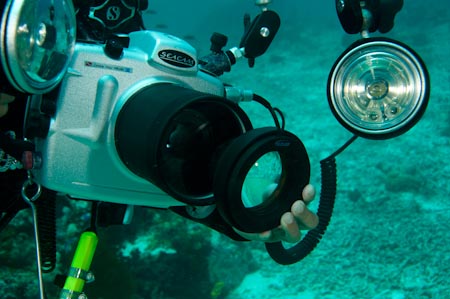
Normally I use a 105mm Micro lens for close ups. If I need to get closer to my subject, I attach a set of external close up lenses

In Misool, Raja Ampat, Indonesia, I photographed these tiny clownfish eggs, eyes wide open and about ready to hatch. They were the size of a tiny rice grain
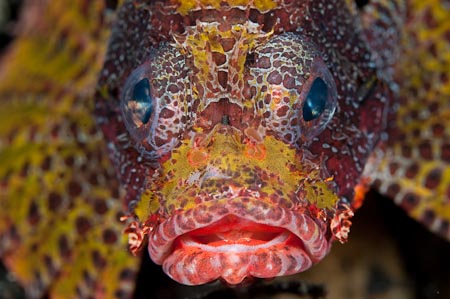
Lembeh Strait is probably the capital of uw macro photography. The number of weird and interesting animals is staggering.
We dived with Lembeh Divers from Lembeh Island.
The problem with still images is, well, they are still. But the underwater world is in constant motion. Only video can show these dynamic movements properly. But on rainy or cloudy days or in the evenings, even an underwater photographer can bring motion into a still picture. It helps when the surrounding environment is rather dim and yet the ambient light can still be captured with the strobes. I use a longer exposing time at, let’s say 1/8th of a second and flash the moving subject while I move along with it. This takes quite a few trial runs but generally there is a goodie that comes out in the collection.

Stella flying along the edge of the coral reef in an extremely strong current in Tubbataha Reef, Philippines
Link to Tubbataha Reef entries.
TOPSIDE PHOTOGRAPHY
For topside, I mostly used the following Nikon lenses: 14-24mm, 24mm tilt/shift, 24-70mm, 70-300mm and the 80-400mm.

Bird Island in Tubbataha Reefs is one of the last breeding grounds for sea birds in the Philippines. I had to sneak up on crested terns without scaring them away so I photographed them with a 80-400mm tele zoom….
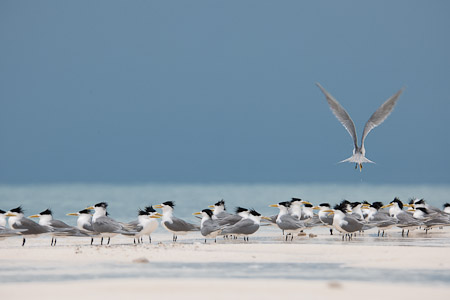
….and this is how the flock looks like
If there was no light (as in shooting in the dark) I had to bring my own form of flash or strobes. Aside from the uw strobes, we brought three SB800 topside flashes which I mostly triggered wirelessly with a SU800 control unit. This gave me freedom from cable clutter and flexibility in positioning the strobes.
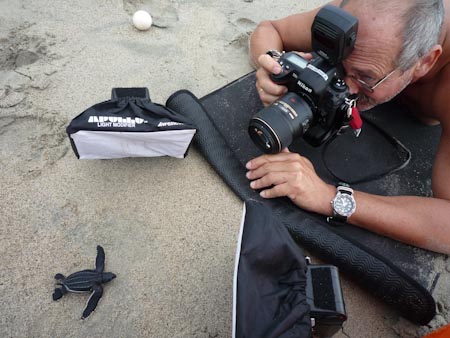
In West Papua we were so privileged to witness the nesting and hatching of very rare Leatherback Turtles. The bulk of about 100 baby turtles emerges at night from their nests, but a few stragglers always get stuck in the chute of the nest unable to come out on its own. Following the tracks of their faster brethren, our WWF Patrollers located the nests and freed them from their sandy burrow of 2 months. We took a few pictures and then released the babies to the ocean. Here is where the wireless flash control went to work …..
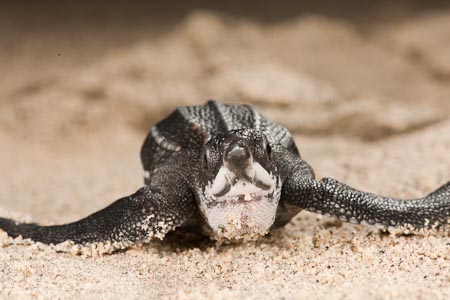
……and this is how the baby turtle looks like
Link to Leatherback turtles of West Papua entries.
A big part of our photo assignment was to show all sorts of fishing activities in the Coral Triangle – artisanal, commercial, small and big time. A lot of fishing happens at night and very often involve pump lamps or Petromax lamps. These kerosene fueled lamps deliver a very beautiful golden light. But in order to portray it perfectly, the time of day matters. There is only a 15 minute window – about 30 minutes after sunset, when the ambient surrounding light is about equal to the artificial light.
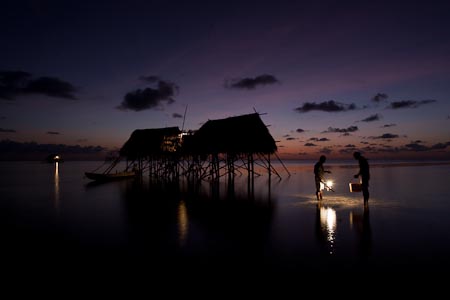
These two fishermen walk with their Petromax lamp at low tide on the reef flat to look for invertebrates and other creatures to glean which is a very common practice in the Coral Triangle. This shot was taken on a tripod at 5 seconds exposing time. I asked the two fishermen to stand still and not move during this 5 second exposure.
Link to WWF in Wakatobi, South Sulawesi, Indonesia entries.
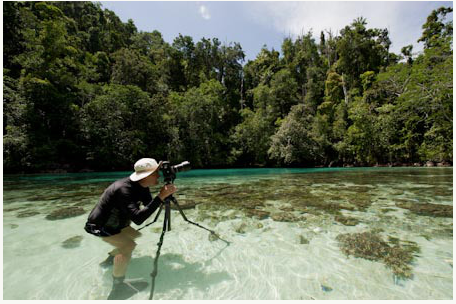
I brought an older Manfrotto carbon tripod in which I exchanged all corrodible nuts and bolts to stainless steel ones. The expensive ball-head is an Arca Swiss one with “Really Right Stuff” quick release clamps and plates. The ball-head should never get in contact with saltwater. This picture was taken in a magical lagoon near Misool Eco Resort, Raja Ampat, Indonesia.
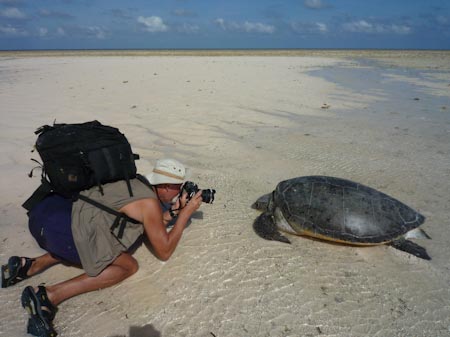
All topside gear was packed in this Mountainsmith “Parallax” backpack. Well, it weighed about a ton on my back and I carried it ALL THE TIME. This picture was taken in Moromahu Island, Wakatobi, Indonesia where this mother green turtle struggled to go back to sea at the height of the morning heat after laying her eggs that evening. She still had a long way to go till the water and we couldn’t bring her there – she was too heavy 🙁
Beside diving and uw photography my other great passion is aerial photography. At some points on our epic journey we had the opportunity to hop on helicopters and small planes. Best done without doors or windows to sniff some really fast air. Just as fast have to be the exposure times of my cameras (at least 1/500s), otherwise the pictures turn out blurry.
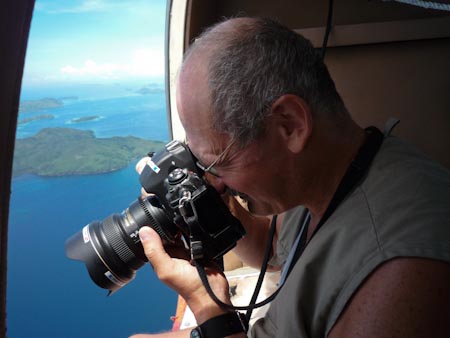
With Jacques Branellec as pilot in his helicopter around the Tay Tay Island, Philippines.
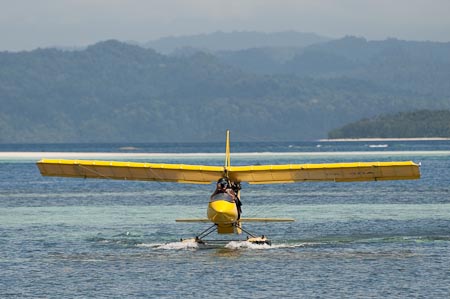
With Max Ammer in his yellow ultralight near his Resort in Kri Island, Raja Ampat, Indonesia.
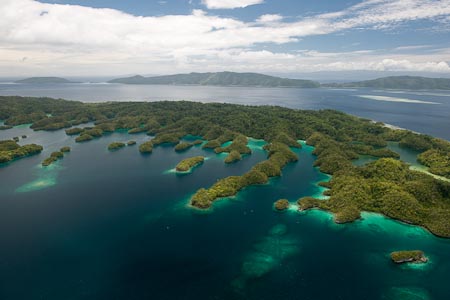
The beautiful Islands of Raja Ampat.

Island near Tay Tay, Palawan, Philippines.
POST PRODUCTION
Shooting is the fun part of photography and many travellers we met along the way envied our work calling it “vacation”. Well, there is more to it than that. There is editing and post production after the shooting. For all the computer work I have to do, 80% of my editing time is working with Adobe Lightroom 3, and the rest is with Adobe Photoshop CS5. Images have to be sorted out – selecting, deleting, colour correcting, cleaning out all the sensor dust of the image and finally properly captioning the selected and corrected photos. This requires 2 to 3 times more work than the shooting time.
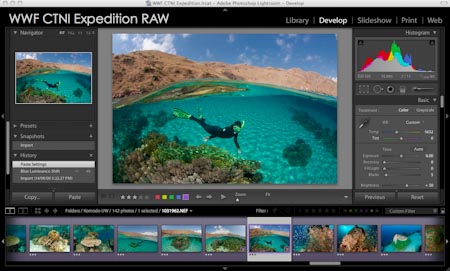
This is how a part of the Komodo UW shoot looks like in Adobe Lightroom
We are constantly working. We had zero weekends, no holidays, no breaks at all during these past 18 months. Our schedules and obligations were so tight. We knew if we took a break, we would lose momentum and suffer the consequences later on.
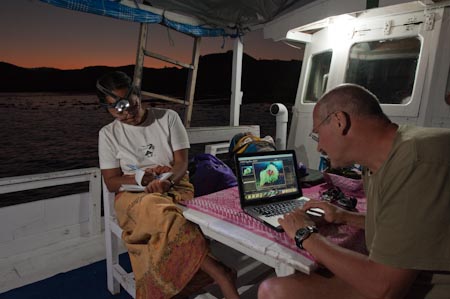
Evenings were reserved for photo editing, even if there was a nice sunset in Komodo Island
If you want to keep updated with our new expedition blog entries, please sign up to our RSS feed by clicking hereor clicking on the “Subscribe to this blog!” link at the top right of this page.
And to look up past entries, go all the way down and click into << older posts. Or go to the Archives on the upper right column of this page.
For more pictures of my work please visit www.jurgenfreund.com.

